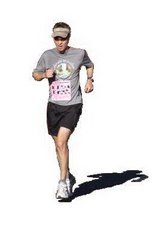I've mentioned VDOT a couple of times already, but what the heck is it, and why do I care?
VDOT is the brainchild of running coach Jack Daniels. It's just a number that represents a runner's ability. It combines VO2 max and economy, as well as lactate threshold and even hard-to-quantify qualities like mental toughness.
The beauty of using the VDOT system is its simplicity. To find out your VDOT, just look up a recent race time in the VDOT Table. If you've run several races of different lengths recently, go with the one that results in your highest VDOT.
As I mentioned earlier, I'm using my 10k personal best time of 40:39, which gives me a VDOT of 51. That race result is almost two years old, so I may need to adjust my VDOT after I run my next 5k, hopefully in a few weeks.
Now that you know your VDOT, what do you do with it? Here we get to the practical aspect. Look up your VDOT in the Training Intensities Table, and suddenly you know exactly what pace to train for all your workouts. For example, my workout tomorrow calls for 6 x 400 at R-pace. I look it up in the table and see that I should run the 400s in 86 seconds. This is great for people like me who a) are not that knowledgeable about running, b) don't want to bother with hiring a personal coach, and c) still want to train smart.
 It's important to realize that your VDOT number is not an estimate of your VO2 max. To make this crystal clear, let's look up the VDOT of a famous athlete, Lance Armstrong. He ran the New York Marathon last November in 2:59:36. That corresponds to a VDOT of 54. But we know that Lance has a VO2 max of 85 ml/kg/min, which is truly an elite-level of oxygen utilization.
It's important to realize that your VDOT number is not an estimate of your VO2 max. To make this crystal clear, let's look up the VDOT of a famous athlete, Lance Armstrong. He ran the New York Marathon last November in 2:59:36. That corresponds to a VDOT of 54. But we know that Lance has a VO2 max of 85 ml/kg/min, which is truly an elite-level of oxygen utilization.
Clearly, 54 and 85 are two different numbers. What accounts for the difference? Economy. The fact is, Lance is just not a very efficient runner (that is, compared to elite runners). He's got a great VO2 max, but relatively poor economy. That's why VDOT is not an estimate of VO2 max -- it combines several different factors, and athletes with the same VDOT may arrive there through different combinations.
Ok, enough about that for now.
I had a fun run today - 7 miles easy, with six strides, averaging 8:13 per mile. That's a little slower than my recommended easy pace of 8:07, but I don't think it matters too much. It was cool and overcast, good running weather. Looking at my training plan, I should relish today's run, because there aren't too many easy days like this remaining on it!


No comments:
Post a Comment